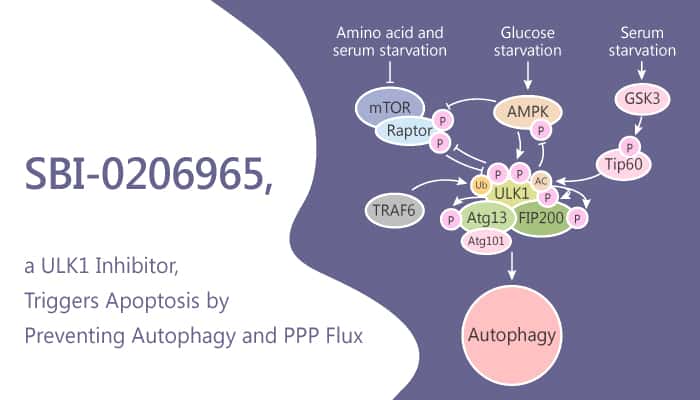Autophagy is a central cellular mechanism for the elimination of damaged proteins, protein complexes, and organelles. ATG1 gene is notable for being the only core autophagy gene to encode a serine/threonine kinase. Atg1 forms a complex with multiple regulatory subunits, including Atg13 and Atg17. In mammals, there are two Atg1 homologs, ULK1 and ULK2, which similarly bind to an Atg13 homolog and an Atg17-like protein, FIP200. Nutrient deprivation activates the ULK1 kinase complex, and it serves as a critical initiator of starvation-induced autophagy.
ULK1 mRNA expression is significantly upregulated in clear cell renal cell carcinoma (ccRCC) and overexpression of ULK1 correlates with poor outcomes. Knockdown of ULK1 and selective inhibition of ULK1 by SBI-0206965 induces cell apoptosis in ccRCC cells. The compound SBI-0206965 is a highly selective ULK1 kinase inhibitor. It suppresss ULK1-mediated phosphorylation events in cells, regulating autophagy and cell survival. In addition, SBI-0206965 shows IC50s of 108 nM for ULK1 kinase and 711 nM for the highly related kinase ULK2.

In this study, SBI-0206965 inhibits autophagy by increased levels of LC3B I and the autophagy substrate p62. Meanwhile, SBI-0206965 decreases the ratio of NADPH/ NADP+. Moreover, SBI-0206965 clearly influences ROS levels compared DMSO-treated control group. Pentose phosphate pathway (PPP) is a major contributor of equivalents in the form of reduced NADPH for intracellular ROS homeostasis. Taken together, SBI-0206965 induces ccRCC cells apoptosis through autophagy and PPP Inhibition.
In vivo, SBI-0206965 do not display signs of toxicity such as agitation, indigestion, or diarrhoea, impaired movement or posture, or areas of redness or swelling in nude mice bearing with A498 cells. Moreover, SBI-0206965 do not affect the renal structure in mice. SBI-0206965 increases cell apoptosis in the tumour samples. Thus, it suggests that SBI-0206965 mediated anti-tumour effects.
All in all, SBI-0206965 triggers apoptosis by preventing autophagy and pentose phosphate pathway (PPP) flux. SBI-0206965 results in a level of anticancer effect in vivo. Therefore, SBI-0206965 should be further considered as an anti-ccRCC agent.
Reference: